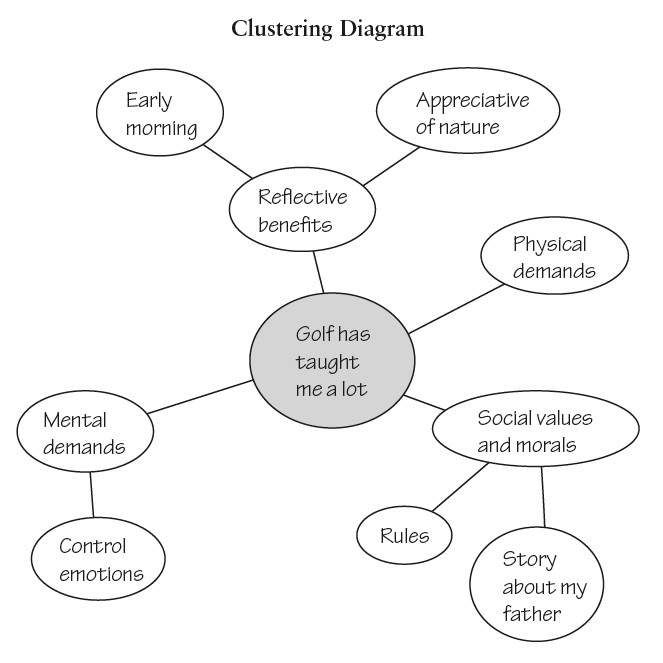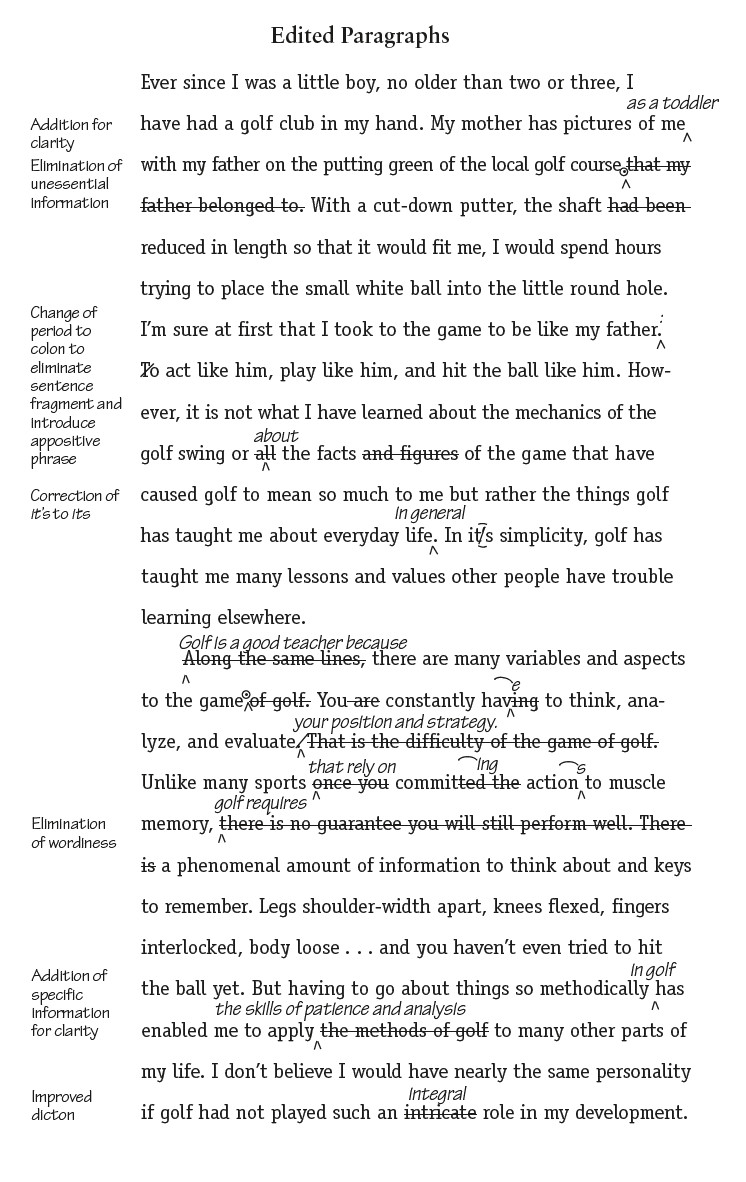Introduction
Authors: Alfred Rosa & Paul Eschholz
Activity Objective: Jeffrey Olesky has been asked to write an essay using a suitable method of development. He has chosen to write about golf. Golf has been a part of Olesky's life since he was a youngster, so he figured he would have enough material for an essay.
Click the forward and backward arrows to navigate through the slides. You may also click the above "Outline" button to see an overview of all the slides in this activity.
Brainstorming
First, Jeffrey Olesky needed to focus on a specific topic within the broad subject area of golf. Having considered a number of aspects of the game—how it's played, its rise in popularity, the controversies over the exclusion of women and minorities from private clubs—he kept coming back to how much golf meant to him. Focusing on his love of golf, he established his tentative thesis: Golf has taught me a lot.
Now Olesky needs to develop a number of examples to support his thesis, so he is brainstorming for ideas, examples, and anecdotes—anything that came to mind to help him develop his essay. These are his notes.
Golf is my life—I can't imagine being who I am without it.
I love to be out on the course early in the morning.
It's been embarrassing and stressful sometimes.
There's so much to know and remember about the game, even before you try to hit the ball.
The story about what my father taught me—felt badly and needed to apologize. "You know better than that, Jeffrey."
Golf teaches life's lessons. Golf teaches you manners, to be respectful of others. Golf teaches you to abide by the rules.
Golf is an internal tool.
Question
sa4ZyLE63oKrF0opik+cMxiD+5i9AzjzM4tnNvNQrQ6ZJJnO/ZIEyxVo7A9teX9Ido8v+cfXfk9YJDLWDBqG2qnUjff/XOmhJRL4w52aoIWFrBpLB3keBTwiiKuIOdZzbDhh0NjF1A7Hc3rlnHiLSkcZ6s4b+XWeyw1ztvGUX5LSyGLA/E4UEZXMoMQF6bZ0L2ae+tvSEGfnb+cFTW+65Ktt4Atx1pSFXHVD06TRtUN6ycGl8dMTHofScrQsa/TuPJPzUKOTxo8CuY54Brainstorming, Part 2
When he thought that he had gathered enough information, Jeffrey Olesky began to consider an organizational plan, a way to present his information in a logical manner. He realized that the character-building benefits of golf that he included in his brainstorming notes clustered around some key subtopics. He decided to do some clustering and drew circles that included his ideas about golf: the physical and mental demands of the game, the social values and morals it teaches, and the reflective benefits of golf. He then sorted out his related ideas and examples and added them, mapping their relationship in this diagram.

Question
OGDrj98ROnsX1qfDeUIQ+mg1hn+KXte8odVKH7wbIZzkMwVChuVQ9ky8/bED0vki8V63eAdBymjFBH3FRRyqVsIQCPsNGU1s+pifgwJb9tGlt/IOCPARtZsLpqciYHvKydeXl6j43TXU3Tg/OEXJNGFKzC4hgjXwJ9ybx8L9lEVP8UGWrCd5RYnLoMc5nXAqPqOMZ6cz0kFoPv9LXkGhsR5QVxJA8yiRPmMWgsI8SjuNpuPfJZkgEasRy2zeP9IbaTDhBafcLl/ilD3TYEpfF8L9ObvmQY787SdJcDKiOog=Outlining
Before beginning to write the first draft of his essay, Jeffrey Olesky thought it would be a good idea to list in an informal outline the major points he wanted to make. Here is his informal outline:
- Brief introductory paragraph announcing the topic
- An expansion of the introductory paragraph and the thesis statement: Golf has taught me a lot.
- A discussion of how, above all, golf teaches one to control one's emotions
- A discussion of how much one needs to know and remember to play golf well
- The social values that golf teaches
- A multiparagraph example illustrating a valuable lesson taught through golf
- Golf provides an opportunity to reflect
- Reflection, in turn, leads to a deeper appreciation of nature
With his outline before him, Olesky felt ready to try a rough draft of his essay. He wrote quickly, keeping his organizational plan in mind but striving to keep the writing going and get his thoughts down on paper. He knew that once he had a draft, he could determine how to improve it. Olesky wrote some fairly solid paragraphs, but he sensed that they were on different aspects of his topic and that the logical order of the points he was making was not quite right. He needed a stronger organizational plan, some way to present his information that was not random but rather showed a logical progression.
Reviewing his outline, Olesky sees that there is a natural progression from the physical lessons of the sport to the social and moral lessons to the psychological, emotional, and even spiritual benefits that one could derive. He decided therefore to move one of the items in his outline to a different place.
Question
GMVf++XSOC3prg5IorUqBuVhSxNQAv108MytigA2eKM6XgOZsCFPDFemP//0i1jA0jygDkfmW55lejGi/NsB1at46hpXYhCGJq28cPwjZtQssWJj3RBNGTo+ORHreAzhcXu4XJB0nS/kyqf5t8+ceKVeaANllFf03lWhTtvNE9GU8xS4VgXYWbQL3AO99Hu90DjR4GDXWISF3kU4KGuOaZ5rOuA=Outlining, Part 2
Jeffrey Olesky moved item 3 in his original organization and made it item 6 in the revision. Here is his reordered outline:
- Brief introductory paragraph announcing the topic
- An expansion of the introductory paragraph and the thesis statement: Golf has taught me a lot.
- A discussion of how much one needs to know and remember to play golf well
- The social values that golf teaches
- A multiparagraph example illustrating a valuable lesson taught through golf
- A discussion of how, above all, golf teaches one to control one's emotions
- Golf provides an opportunity to reflect
- Reflection, in turn, leads to a deeper appreciation of nature
Did you correctly guess which item Olesky moved?
Thesis Statement
Jeffrey Olesky was satisfied that his essay now had a natural and logical organization: it moved from matters of lesser to greater importance to him personally. However, he now needs to revise his thesis to suit the argument he has established. He wants his revised thesis to be focused and specific and to include the idea that the lessons and values golf has taught him could not have been learned as easily in other ways.
Question
c0INr9OhpjQd7dFs6dHFnGYn/I/h0aeUtl3+QWrckraFid8CO7rCsnr2wJAep+d1n0TaSItVACAul57p/6EeyB4UuHC9xMM82Bt/vcu1KT/aBRnbaQKcCIa2ZDDT9Kxn+Nf8YVY50+0xYWT2E9KSkcADzykotYA/SCdPDDGdFheEUTyakB9O0L9/4S8zDlg/jMBJzZQa+so=Thesis Statement, Part 2
Here is the revised thesis statement that Jeffrey Olesky ended up using:
In its simplicity, golf has taught me many lessons and values that other people have trouble learning elsewhere.
How similar is Olesky's thesis to the thesis that you wrote on the previous slide?
Editing
After revising the organization, Olesky was now ready to edit his essay and to correct those smaller but equally important errors in word choice, wordiness, punctuation, and mechanics. He had put aside these errors to make sure his essay had the appropriate content. Now he needed to make sure it was grammatically correct. Here are several sample paragraphs showing the editing Olesky did on his essay:

Final Essay
In addition to editing his revised paper, Olesky reexamined his title, “Character Builder.” He considered a half dozen alternatives and finally settled on the use of “Golf” as a main title because it was such a key word for his topic and thesis; he used “A Character Builder” as his subtitle. He also thought about his conclusion, wondering whether it was forceful enough. After giving it considerable thought and seeking the advice of his classmates, Olesky decided to end with the low-key but meaningful final paragraphs he generated in his original draft. Here is the final version of his essay:

Congratulations! You have helped Jeffrey Olesky through the writing process—and now you are more prepared to write your own essay.